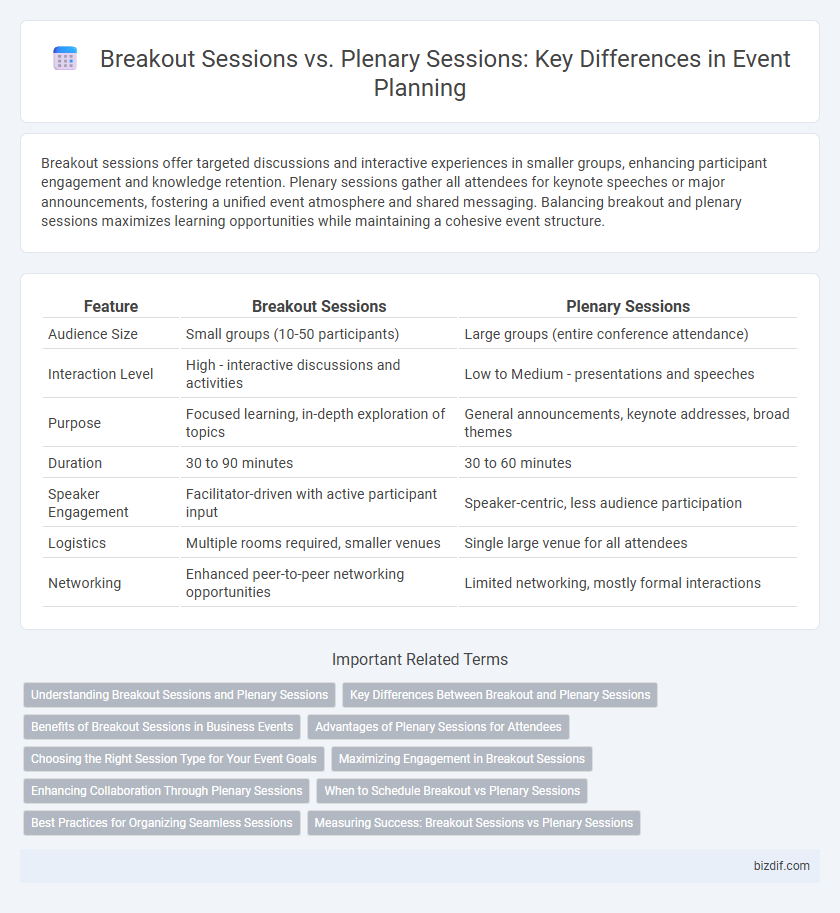Breakout sessions offer targeted discussions and interactive experiences in smaller groups, enhancing participant engagement and knowledge retention. Plenary sessions gather all attendees for keynote speeches or major announcements, fostering a unified event atmosphere and shared messaging. Balancing breakout and plenary sessions maximizes learning opportunities while maintaining a cohesive event structure.
Table of Comparison
| Feature | Breakout Sessions | Plenary Sessions |
|---|---|---|
| Audience Size | Small groups (10-50 participants) | Large groups (entire conference attendance) |
| Interaction Level | High - interactive discussions and activities | Low to Medium - presentations and speeches |
| Purpose | Focused learning, in-depth exploration of topics | General announcements, keynote addresses, broad themes |
| Duration | 30 to 90 minutes | 30 to 60 minutes |
| Speaker Engagement | Facilitator-driven with active participant input | Speaker-centric, less audience participation |
| Logistics | Multiple rooms required, smaller venues | Single large venue for all attendees |
| Networking | Enhanced peer-to-peer networking opportunities | Limited networking, mostly formal interactions |
Understanding Breakout Sessions and Plenary Sessions
Breakout sessions provide smaller, focused group discussions or workshops that encourage participant interaction and personalized learning, enhancing engagement and knowledge retention. Plenary sessions bring all attendees together in a single space for keynote speeches or major presentations, ensuring consistent messaging and shared experiences. Choosing between breakout and plenary formats depends on event goals, audience size, and the desired level of engagement.
Key Differences Between Breakout and Plenary Sessions
Breakout sessions involve smaller groups focusing on specific topics, enabling detailed discussions and interactive participation, whereas plenary sessions gather all attendees for broad presentations or keynote speeches. Breakout sessions enhance personalized learning and networking through targeted content, while plenary sessions provide unified messaging and shared experiences across the entire event audience. The key differences lie in group size, interaction level, and content specificity, making each session type essential for different objectives in event planning.
Benefits of Breakout Sessions in Business Events
Breakout sessions in business events foster targeted networking and deeper engagement by allowing smaller groups to focus on specific topics relevant to their interests or roles. These sessions enhance learning retention and encourage active participation through interactive discussions, workshops, and collaborative problem-solving. By tailoring content to diverse attendee needs, breakout sessions drive more meaningful connections and actionable insights compared to plenary sessions.
Advantages of Plenary Sessions for Attendees
Plenary sessions provide attendees with a unified experience, ensuring access to key information and insights from expert speakers in a shared environment. These sessions foster collective engagement, allowing participants to benefit from diverse perspectives and real-time interactive discussions. The centralized format enhances networking opportunities and reinforces the event's main themes, maximizing overall attendee value.
Choosing the Right Session Type for Your Event Goals
Selecting breakout sessions enables targeted, interactive discussions that foster networking and deep dives into specific topics, ideal for workshops and skill-building events. Plenary sessions, hosting all attendees simultaneously, provide a unified platform for keynote speeches and major announcements, enhancing shared experience and collective engagement. Aligning session type with event goals ensures optimized attendee participation and message retention, maximizing overall event impact.
Maximizing Engagement in Breakout Sessions
Breakout sessions maximize engagement by fostering smaller group interactions that encourage active participation and personalized discussions, unlike plenary sessions which often involve passive listening. Utilizing interactive tools such as live polls, Q&A segments, and collaborative activities enhances attendee involvement and knowledge retention. Tailoring breakout content to specific interests or expertise levels ensures deeper connections, boosting overall event satisfaction and effectiveness.
Enhancing Collaboration Through Plenary Sessions
Plenary sessions foster enhanced collaboration by bringing all participants together in a shared space, facilitating unified discussions and collective decision-making. These sessions enable real-time interaction among diverse groups, promoting the exchange of ideas and building consensus more effectively than breakout sessions. By aligning all attendees around common goals, plenary sessions create a cohesive environment that strengthens teamwork and drives event objectives forward.
When to Schedule Breakout vs Plenary Sessions
Schedule breakout sessions during times when attendee engagement and interaction are essential for deep dives into specific topics, such as mid-morning or early afternoon to maintain energy levels. Reserve plenary sessions for the beginning and end of the event to address the entire audience with keynote speakers, overarching themes, or major announcements that set the tone and summarize key takeaways. Timing breakout sessions after plenary sessions enables participants to discuss and apply insights in smaller, focused groups, enhancing learning and collaboration.
Best Practices for Organizing Seamless Sessions
Breakout sessions require clear scheduling, smaller group facilitation, and interactive content to maximize participant engagement and learning outcomes. Plenary sessions benefit from strong keynote speakers, concise presentations, and technology integration for live polling or Q&A to maintain audience attention. Seamless event flow depends on precise timing, effective communication, and coordinated logistics between breakout and plenary activities.
Measuring Success: Breakout Sessions vs Plenary Sessions
Measuring the success of breakout sessions versus plenary sessions involves evaluating attendee engagement, knowledge retention, and interaction levels. Breakout sessions typically yield higher engagement and personalized learning outcomes due to smaller group sizes and focused discussions. Plenary sessions often measure success through overall attendance rates and speaker impact metrics, reflecting broad audience reach and shared experiences.
Breakout sessions vs Plenary sessions Infographic

 bizdif.com
bizdif.com